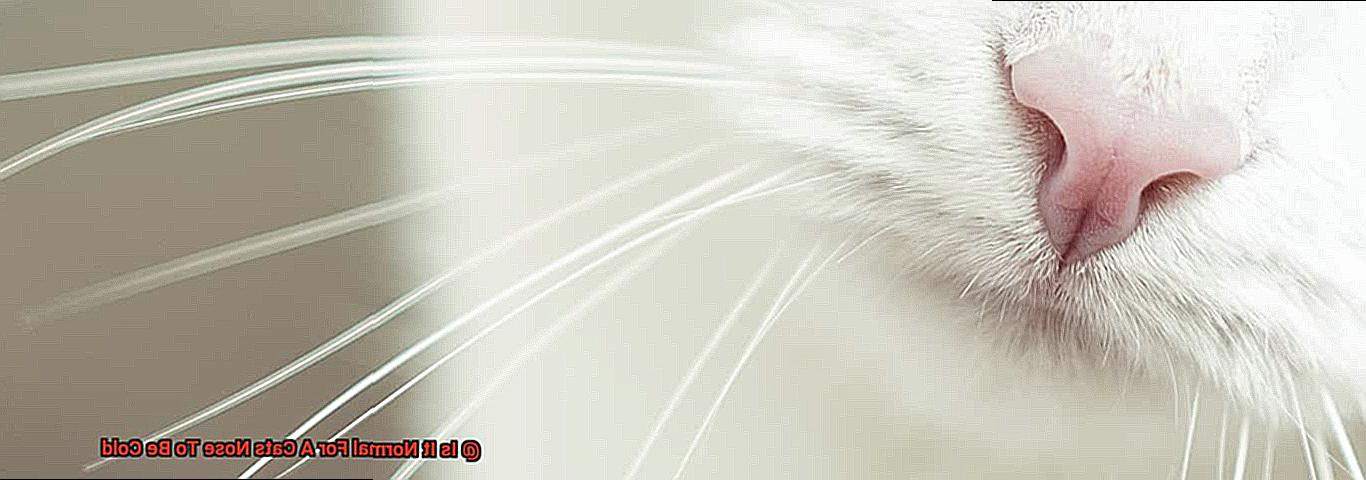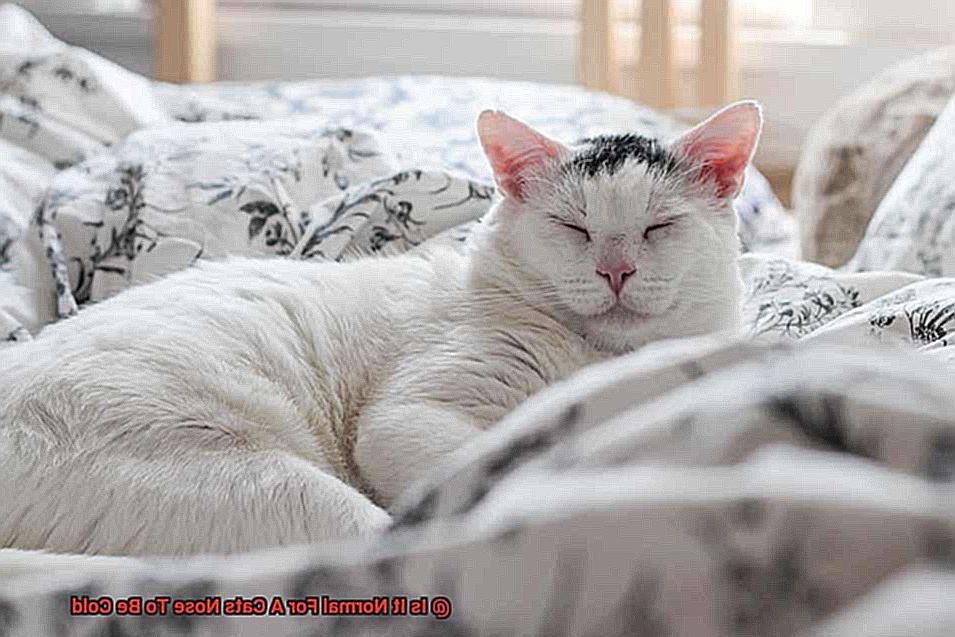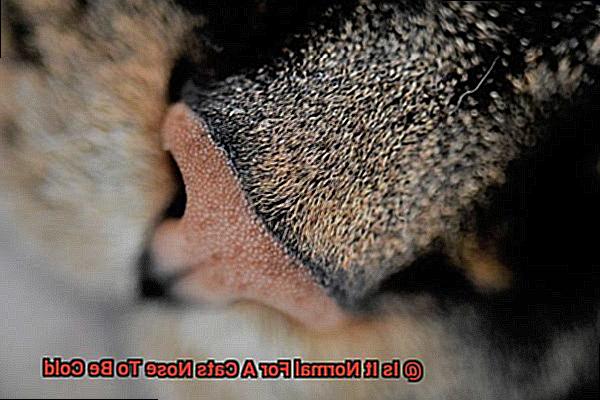As cat owners, we’re all too familiar with the enigmatic ways of our beloved pets.
They can be playful one minute and aloof the next, leaving us constantly wondering what’s going on inside their furry little heads. But one question that often comes to mind is whether it’s normal for a cat’s nose to feel cold.

We’ve all experienced the sensation of a chilly kitty snout and wondered if it’s a sign of something more serious. Well, fear not fellow cat lovers, because in this blog post, we’ll unravel the mystery behind why cats have cold noses and put any concerns to rest.
So, grab your curious kitties and let’s embark on this adventure together.
Is It Normal For A Cats Nose To Be Cold?
Contents
The short answer is yes, it is perfectly normal for a cat’s nose to feel cold. However, there may be some underlying reasons why your cat’s nose feels cooler than usual.
In this blog post, we will dive into the various factors that can affect a cat’s nose temperature and why it may feel cold to the touch. We will also discuss when a cold nose could be a sign of an underlying health issue and when it is not a cause for concern.
Factors That Affect A Cat’s Nose Temperature:
- Environment: Just like humans, cats can also feel the effects of cold weather. When the air is cold or dry, the blood vessels in a cat’s nose may constrict to conserve heat and moisture, making their nose feel colder to the touch.
- Activity level and emotional state: When a cat is resting or sleeping, their body temperature may drop slightly, causing their nose to feel cooler. On the other hand, when a cat is active or excited, their body temperature may rise, making their nose feel warmer.
- Grooming habits: Cats are known for their meticulous grooming habits. During this process, they produce saliva which evaporates and cools down their body temperature. As a result, this can also cause their nose to feel cold.
When A Cold Nose Could Indicate A Health Issue:
While a cold nose is usually not a cause for concern, there are certain situations where it could indicate an underlying health problem. If your cat’s nose feels consistently hot or unusually cold to the touch, it could be a sign of an infection or fever. Other symptoms such as lethargy, loss of appetite, and vomiting may also accompany a warm nose. In contrast, a cold nose accompanied by sneezing, discharge, and difficulty breathing could be a sign of an upper respiratory infection.
When To Seek Veterinary Care:
If you notice any concerning symptoms accompanied by a warm or cold nose in your cat, it is essential to seek veterinary care right away. A veterinarian will be able to assess your cat’s overall health and determine if there is an underlying issue that needs to be addressed.
The Normal Temperature of a Cat’s Nose
Before you panic, let’s dive into the topic of a cat’s nose temperature. As an expert on all things feline, I’m here to give you the lowdown on what is considered a normal temperature for your cat’s nose and what factors may affect it.
Normal Temperature Range:
The web search results state that a cat’s nose temperature typically falls within the range of their surrounding skin temperature, which is around 100.4º to 102.5º Fahrenheit. However, this range can vary depending on various factors, such as physical activity, time of day, and overall health. So, if your cat’s nose feels slightly warmer or cooler than usual, it may not necessarily indicate a problem.
Environmental Conditions:
Just like us humans, cats’ noses can also feel cold or warm due to environmental conditions. For example, if your cat has been lounging in the sun or near a heater, their nose may feel warmer than usual. On the other hand, if they have been outside in colder weather or near a drafty window, their nose may feel colder.
Cat-to-Cat Variations:

Each cat is unique and may have different nose temperatures and moisture levels. Some cats may have a cold and wet nose most of the time, while others may have a warm and dry nose. This does not necessarily mean that one cat is healthier than the other. Just like humans have different body temperatures, cats can also have variations in their nose temperature.
When to Worry:
While a cat’s nose temperature can fluctuate depending on various factors, there are times when it could be a sign of a potential health issue. If your cat’s nose suddenly feels unusually warm or cold, or if you notice any other concerning symptoms such as loss of appetite, lethargy, sneezing, or vomiting, it is best to seek veterinary care. Also, if your cat has a fever above 106º F, it is important to contact your vet immediately.
Factors That Affect the Temperature of a Cat’s Nose
When it comes to our furry feline friends, it’s natural for us to worry about their well-being. One thing that often causes concern for cat owners is the temperature of their cat’s nose. Is it too cold? Too warm? What does it mean? As an expert on this topic, I’m here to shed some light on this common concern and help you understand the potential factors that can affect your cat’s nose temperature.
Environmental Factors:
Like humans, cats’ noses can feel cold or warm depending on the environment they are in. If your cat is exposed to colder temperatures, such as in the winter or in an air-conditioned room, their nose may feel cooler than usual. On the other hand, if your cat is in a warmer environment, such as in the summer or in a heated room, their nose may feel warmer than usual.
Activity Level:
The temperature of a cat’s nose can also change depending on how active they are. After playing or running around, their nose may feel warm due to increased blood flow from physical activity. Conversely, after resting or sleeping, their nose may feel cooler as their body is not exerting as much energy.
Health Factors:
While a cat’s nose temperature can indicate potential health problems, it shouldn’t be used as the sole indicator of illness. A fever or infection can cause a cat’s nose to feel hot and dry, while dehydration can make it feel cold and wet. However, other symptoms should be considered along with the temperature of their nose before jumping to any conclusions.
Age:
As cats age, their noses may also change temperature due to changes in their body composition. Kittens tend to have cooler noses because they have less body fat and less ability to regulate their body temperature.
On the other hand, older cats may have warmer noses due to a decrease in body fat and a slower metabolism.
When to Be Concerned: Abnormalities in a Cat’s Nose Temperature
When it comes to our furry feline friends, we want to make sure they are healthy and happy. As responsible cat owners, we know the importance of monitoring our cat’s nose temperature.
But how do we know when to be concerned about abnormalities? And how do we accurately measure it? Let’s dive into this mystery and uncover the truth about your cat’s nose temperature.
Factors that Affect Your Cat’s Nose Temperature
First, let’s establish that a cat’s nose temperature is not a reliable indicator of health by itself. A cat’s nose can vary in temperature depending on their environment, activity level, and grooming behavior.
For example, if your cat has been basking in the sun, their nose may feel warmer than usual. Similarly, if they have been running around and playing, their nose may feel cooler due to increased blood flow.
When to be Concerned
While a warm or dry nose is not necessarily a cause for concern, it can sometimes indicate a fever or infection. If your cat’s nose feels unusually warm or dry and is accompanied by other signs of illness such as lethargy, loss of appetite, vomiting, or dehydration, it is best to consult your veterinarian for further evaluation. These symptoms could be a sign of an underlying health issue that requires medical attention.
How to Measure Your Cat’s Nose Temperature
The most accurate way to measure your cat’s body temperature is by using a digital thermometer to take their rectal temperature. The normal range for a cat’s rectal temperature is between 100.4º and 102.5º Fahrenheit. A fever in cats occurs when the temperature rises above 102.5º F.
Tips for Caring for Your Cat
Aside from monitoring your cat’s nose temperature, there are other signs you can look out for to ensure your furry friend is in good health. These include their behavior and appetite. If you notice any changes or concerns, it is best to consult your veterinarian for a check-up.
In addition to regular check-ups, it is essential to maintain your cat’s overall health by providing them with a nutritious diet, plenty of water, and regular exercise. Grooming your cat regularly can also help keep their body temperature regulated and prevent any potential skin issues.
Common Health Issues Related to Cold or Warm Noses in Cats
One moment they’re snuggled up in our laps, purring contently, and the next they’re off exploring the world with their curious noses. Speaking of noses, have you ever wondered about your cat’s nose temperature? Is it normal for it to be cold or warm? Well, you’re not alone. Many cat owners have questions about their furry companion’s nose temperature and what it could mean for their health.
Let’s start with the basics. A cat’s nose temperature can vary depending on several factors, such as the environment, activity level, and hydration status. It’s completely normal for a cat’s nose to be cold or warm at different times of the day. However, if you notice a sudden change in your cat’s nose temperature accompanied by other signs of illness or discomfort, it could be an indication of a health issue.
So what are some common health issues that can affect a cat’s nose temperature?
- Cat flu – Just like humans, cats can also catch a cold. Cat flu is a viral infection that can cause symptoms such as sneezing, nasal discharge, and congestion. These symptoms may result in a warm and wet nose due to inflammation and mucus production.
- Allergies – Cats can also be allergic to certain substances like pollen, dust, or food. Allergies can cause nasal irritation and inflammation, resulting in a warm and dry nose. Look out for other signs like itching, scratching, or skin problems.
- Foreign body – Cats are curious creatures and can sometimes inhale or ingest something that gets stuck in their nasal cavity. This can cause nasal obstruction and irritation, leading to a warm and wet nose. Keep an eye out for sneezing, bleeding, or discharge from the nose.
- Fungal infection – Although rare, fungal infections in the nose can be serious, especially for cats with weakened immune systems. These infections can cause nasal swelling, ulceration, and discharge, resulting in a warm and wet nose. Fungal infections can also spread to other parts of the body.
- Nasal polyps – These are benign growths that can obstruct the nasal passage and cause inflammation, leading to a warm and dry nose. Look out for signs like difficulty breathing, snoring, or nasal discharge.
Tips for Monitoring Your Cat’s Nose Temperature and Overall Health
One way to monitor their health is by keeping track of their nose temperature. But do you know exactly how to do it? In this guide, we’ll walk you through the steps of monitoring your cat’s nose temperature and overall health, with easy-to-follow instructions and tips.
First things first, let’s understand your cat’s nose temperature. A cat’s nose temperature can vary depending on many factors such as the environment, time of day, and activity level. A warm or cold nose does not necessarily mean that your cat is sick or healthy. The best way to monitor your cat’s nose temperature and overall health is by taking their rectal temperature with a digital thermometer.
Now, before you panic at the thought of taking your cat’s rectal temperature, let me assure you that it is a straightforward and painless process. To do so, you will need a lubricated thermometer, alcohol, paper towel, and a cat treat to reward your feline friend for being a good sport.
To take your cat’s rectal temperature, follow these simple steps:
- Shake a glass thermometer so the mercury is below the 96º line. To check, hold it up to the light and rotate it.
- Lubricate the thermometer with petroleum jelly.
- Hold your cat securely in your lap or have someone else hold them.
- Lift your cat’s tail and gently insert the thermometer about an inch into the rectum.
- Hold the thermometer in place for two minutes or until it beeps.
- Remove the thermometer and read the temperature.
- Clean the thermometer with alcohol and paper towel.
- Give your cat a treat and praise them for being a good kitty.
Once you have taken your cat’s rectal temperature, it is essential to also monitor their behavior and appetite. Keep an eye out for any changes, such as loss of appetite, depression, lack of energy, hiding, decreased grooming, shivering, or rapid breathing. These could be signs that your cat is not feeling well.
Furthermore, it is crucial to understand what changes in your cat’s nose temperature may indicate. A fever in cats occurs when their temperature rises above 102.5º F. If your cat has a fever for more than a few days with no apparent reason, you should consult your veterinarian as soon as possible.
But what if your cat’s nose feels consistently warm or cold to the touch? While it is normal for a cat’s nose to feel cold, a consistently hot or unusually cold nose could be a sign of an underlying health issue. A warm nose accompanied by other symptoms such as lethargy, loss of appetite, and vomiting could indicate a fever or infection. In contrast, a cold nose accompanied by sneezing, discharge, and difficulty breathing could be a sign of an upper respiratory infection.
Grooming Habits and Their Impact on a Cat’s Nose Temperature
They spend hours licking their fur and paws, making sure they are clean and shiny. But did you know that their grooming habits can also affect the temperature of their nose? Yes, you read that right – a cat’s nose temperature can be influenced by their grooming routine.
Let’s dive into the various ways a cat’s grooming habits can affect their nose temperature.
The first way is through their barbed tongue. When cats groom themselves, they use their tongue like a wet brush, wetting their fur with saliva. This allows heat to escape from their body through evaporation, thus regulating their body temperature. The moisture on their fur can also reach their nose, making it wet and cool.
Another source of moisture for a cat’s nose is the tears that drain from their eyes. These tears pass through the nasolacrimal duct and end up in the nose and mouth. This helps to keep the nasal cavity and nose itself moist and healthy.
But grooming doesn’t just involve saliva and tears. Cats may also rub their nose with their paws or other objects. This can affect the temperature of their nose, depending on the warmth or coolness of the object they’re rubbing against.
However, it’s important to note that a cat’s nose temperature is not always a reliable indicator of their health or fever. The only accurate way to know if your cat has a fever is by taking their rectal temperature with a digital thermometer.
Conclusion
In conclusion, cats are fascinating creatures that never fail to surprise us with their mysterious ways. One common question among cat owners is whether a cold nose is normal for their furry companion. The answer? Yes, it is perfectly normal.
Throughout this blog post, we have delved into the various factors that can affect a cat’s nose temperature. From environmental conditions to activity levels and grooming habits, there are many reasons why a cat’s nose may feel cold at times.
However, it is important to keep an eye on your cat’s overall health by monitoring their behavior, appetite, and any changes in their nose temperature. If you notice any concerning symptoms accompanied by a warm or cold nose, do not hesitate to seek veterinary care.
Remember to provide your feline friend with proper nutrition, hydration, and regular exercise to ensure their well-being. And let’s not forget the most crucial ingredient – love and affection.






